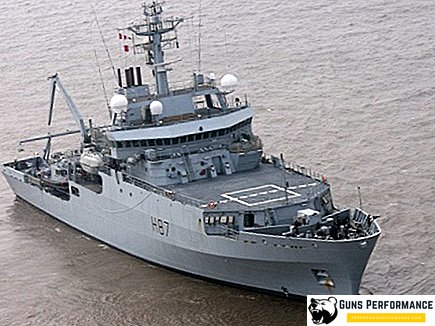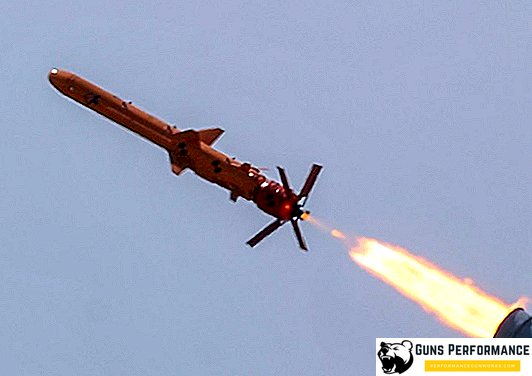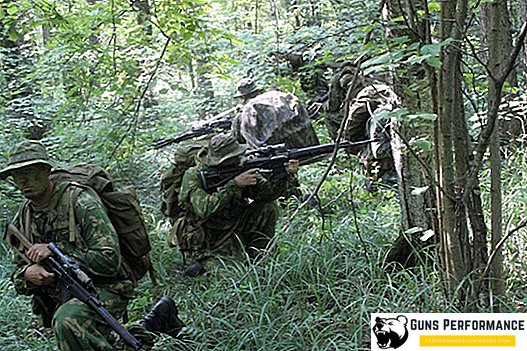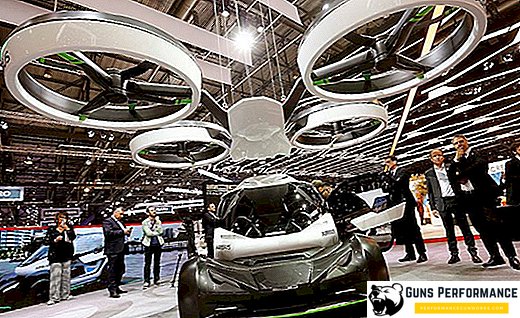M1 Abrams - is the main American tank, which is commercially available since 1981. He belongs to the third post-war generation of tanks. This machine is in service with the army and marines of the United States, it is exploited by several more armies in the world.

Few tanks deserve as much attention as the Abrams. About him written hundreds of articles that often sin subjectivism, and either sing this car laudatory odes, or fall to the indiscriminate (and often undeserved) criticism. This is really a very interesting machine, which is a typical offspring of the western school of tank design. This tank is the brainchild of the Cold War, it was created not to break through the enemy line of defense, but rather as an anti-tank weapon. It was the "Abrams" who were supposed to stop the Soviet tank avalanche, aspiring to the English Channel.
Americans consider the Abrams the best tank in the world, a real death machine that has no competitors. But is this opinion true? Let's understand what are the strengths and weaknesses of this tank.


The history of the creation of the tank M1A1 Abrams
In the late 60s of the last century, the leading countries of NATO stepped up work to create new types of military equipment. The main efforts were aimed at developing new tanks. The reason for this was very simple: the backlog of the United States and its allies from the USSR in this area became more and more. It became especially obvious after the appearance of the newest Soviet T-72 tank.
At that time, the main tank of the US Army was the M60 Patton, whose appearance and characteristics more closely corresponded to the era of the Second World War. The main machine of the Bundeswehr was the "Leopard 1", which also significantly lost to the newest Soviet tanks.

Back in the late 60s, the FRG and the USA tried to jointly create the main tank MVT-70. Such an approach was fully justified, since a single main tank for the leading NATO countries would seriously simplify supply and control in the event of joint combat operations.
But soon between the military departments there were significant differences, and the work has stalled. The Americans wanted to get a tank suitable for any theater of operations, the Bundeswehr, first of all, was interested in Europe. The Germans, given the experience of the Second World War, insisted on a powerful tank gun with a large caliber and high firing range. There were other, less significant differences. The joint project was closed, and each side took up the development of its own tank. Several prototypes of MVT-70 were built, but they turned out to be too expensive and complicated.

The problem of lagging behind the USSR in tank building was so serious that a secret hearing in the US Congress was devoted to it. It was announced on the forcing of work on the creation of a new American tank.
By this time, the United States already had experience in developing a new main tank to replace the outdated M60. I must say that this experience was not too successful. The previous T95 program ended in failure. Tank T95 turned out no better than its predecessor.

At the development stage, the new tank received an XM-1 index. The US military was not immediately able to determine the gun and power plant for a new car. Considered options for installation on the HM-1 105-mm cannon M68, the British rifled 110-mm and the German 120-mm smooth-bore gun. Initially, it was decided to install an M68 gun on the tank with a possible replacement with a 120-mm cannon. Two variants of diesel engines (air and water cooling) and a gas turbine engine were considered as the power plant of the new tank.
In 1973, two American companies filed applications for participation in the competition: General Motors and Chrysler. In the middle of the same year, contracts were signed with them to create prototypes of the new tank.

Great influence on the design and appearance of the new machine had the development of the British technology of multi-layered armor "Chobham." It consisted of ceramic, aluminum and steel sheets fastened with bolted joints, and resisted cumulative and sub-caliber ammunition much better.
Influenced the design of the tank and the experience of the 1973 Arab-Israeli war. He demanded to increase the ammunition of the tank guns and the firing range, to increase the security and maintainability of the tank. Initially, the military wanted to install an M242 Bushmaster automatic cannon coupled with a gun on a new tank, but then abandoned the idea, setting up a 7.62-mm machine gun.

In May 1976, tests began prototypes of the new machine. They showed that both prototypes meet the stated requirements, but Chrysler was able to offer a more interesting price, so it became the winner of the competition. Until 1979, there was a revision of the new machine, the tank received the name "Abrams" in honor of the US Army General, who made a great contribution to the development of American armored forces.
In 1981, the Abrams was officially adopted by the US Army.

Modifications tank M1A1 Abrams
Like most of the main battle tanks that have been in service with their armies for many years (Leopard 2, T-72, Challenger 2), the Abrams experienced many upgrades. The tank, which the US Army uses today, bears little resemblance to the Abrams, adopted for service in 1981.
M1. This is the basic model that has been adopted. It was installed 105-mm rifled gun with ammunition 55 shots.
M1IP. This tank can be called a transitional model for the modification M1A1. On this machine, the frontal armor of the turret was significantly enhanced, the suspension and gearbox were improved, and the tank weight increased by 900 kg.
M1A1. This modification appeared in 1984, its main difference from the basic Abrams model is the installation of a new 120-mm smooth-bore gun. The Americans took the proven German cannon Rheinmetall L44, slightly modified it, changing the breech and the cradle. Due to the increase in caliber, the tank ammunition decreased to 40 rounds. This weapon can use ammunition of the German tank "Leopard-2".

In addition to installing a new weapon, the tank's security was enhanced. M1A1 Abrams has a greater thickness of armor frontal part of the body compared to the base version. The tank was equipped with a new defense system (HLF) against weapons of mass destruction with built-in air conditioning.
Additional body armor, installation of a more powerful gun and a new HLF led to an increase in the machine’s mass by 2.6 tons. Serial production of the M1A1 Abrams lasted until 1993, a total of 3,546 units of this tank were manufactured.

We should not think that all the Abrams tanks of the M1A1 modification were identical. This model was constantly improving, over the years of production, numerous changes were made to it. In 1988, the tank received the first generation uranium armor (M1A1HA), and in a few years and the second (M1A1HA +). In the later modifications of the M1A1 model, the electronic equipment was improved, and more advanced aiming devices appeared.
The M1A1 is the first modification of the Abrams tank that was exported. The first contract was signed with Egypt in 1988. Also, export modifications of the Abrams M1A1 for the ground forces of Iraq and Morocco were specially made.

M1A2 Abrams.This is a fundamentally new modification of the tank, work on which started in the early 90s. In the ten years that have passed since the appearance of Abrams, many technologies have advanced far ahead. First of all, it concerned electronics and computer technologies. The impetus for the creation of the modification M1A2 Abrams was the emergence of a new German tank "Leopard 2" with a perfect fire control system (FCS). The Americans started developing a similar system for their tank. It is the new MSA is the main difference M1A2 Abrams from previous models.

The OMS is built on the basis of a new tire. The M1A2 Abrams tank’s OMS consists of: a stabilized gunner's sight and a thermal imaging device of the commander, a more advanced laser range finder, a thermal imaging observation device for the driver. The developers seriously changed the rest of the onboard equipment of the tank: the car received a new navigation system operating on the basis of satellite navigation and a new generation communication system.

The armor protection of the turret was also increased, the M1A2 ammunition was 42 rounds.
It should be said that the improvements that were made to M1A2, increased its effectiveness in defense by 2 times and 1.5 times in the offensive.
The first tank modification M1A2 appeared in the late 1990s, the US Army had serious plans for this car. However, a year later, the USSR — the main adversary with whom the M1A2 was supposed to fight — had sunk into oblivion, so the plans for the production of the M1A2 Abrams were revised.

Initially, the Pentagon had planned to order 3 thousand cars of modification M1A2, but soon this figure was reduced to 998 units.
Modification M1A2 experienced several modernization programs (SEP, SEP-2, SEP-3), and modern tanks are very different from the cars of the early 90s. The main changes affected the electronic filling of the combat vehicle.

All crew members received the next-generation thermal imagers, the on-board SLA was improved, color monitors and new communication devices appeared. All electronic components were made on the basis of the most advanced processors. The tank also received third generation armor protection, an additional power plant, and a new air conditioning system.
The latest modernization of the Abrams (SEP-3) was completed in 2018. Now the car’s ammunition consists of two standardized ammunition:
- multipurpose XM1147 AMP with a programmable fuse;
- armor piercing projectile M829E4 AKE.
Another modification of the Abrams - M1A2 TUSK, which was developed specifically for the actions of the machine in urban combat, deserves attention. In fact, this is a set of equipment that can be installed on a tank in the field. It includes an additional set of dynamic protection, a thermal sight for the M240 machine gun, special armor shields to protect crew members with open hatches and additional machine guns.

Description of the tank M1A1 Abrams
The main battle tank "Abrams" has a classic layout, with the control compartment located in front, the fighting compartment - in the middle of the machine and the power compartment - in the stern.
The crew of the tank - four people: the commander, loader, gunner and driver.
The hull and turret of the tank are welded, made of multilayer armor using the Chobham technology. The angle of inclination of the frontal armor of the hull and the turret is significant (82 °), there is a large gap between the hull and the turret.

In front of the tank in the center is the place of the driver, as well as mechanisms for controlling the tank and partings. To the right and left of it are fuel tanks. The three remaining crew members are accommodated in the fighting compartment.
In the power compartment are the engine and transmission, combined into a single unit.
In the later versions of the Abrams, a smooth-bore M256 gun with a caliber of 120 mm was installed. Unitary tank ammunition. The ammunition includes armor-piercing sabot and cumulative projectiles, framing and high-explosive fragmentation ammunition with a programmable fuse.

The M240 machine gun is paired with a gun, another similar machine gun is in front of the loader's hatch, a 12.7 mm machine gun located on the commander's turret.
Ammunition is located in the stern niche, separated from the combat compartment by an armored partition. In the niche there are expelling panels, with the defeat of this compartment, the energy of the explosion goes up.
The engine compartment is equipped with a powerful fire extinguishing system.

"Abrams" is equipped with a gas turbine engine AVCO Lycoming AGT-1500 with a capacity of 1500 liters. with. Gas turbine engine (GTE) has significant advantages: it has more power density, it is quite simple and reliable, has less noise and works better at low temperatures. But at the same time GTE consumes more fuel (than diesel) and is very picky about air quality. The Abrams air cleaning system is larger than the engine itself.
Transmission - automatic, provides four speeds forward and two back.
The running gear consists of seven basic and two supporting skating rinks on each side. Suspension - torsion.
The fire control system installed on the later versions of the Abrams, is today considered one of the best in the world. All crew members (except the loader) have thermal imaging sights or observation devices. There is a perfect laser range finder and a lot of other sensors on the machine, the electronic ballistic computer automatically processes information from the range finder, taking into account a huge number of factors.
On the latest modifications of the tank, a tank information-control system, a modern navigation system, and a radio station are installed. The latest Abrams models have a FBCB2-EPLRS command and control system through which they interact with other tank battalion vehicles.

Combat use

"Abrams" - this is the main American battle tank. For this reason, the car was involved in all the recent conflicts in which the United States participated.
The first real test for Abrams was Operation Desert Storm in 1991. Both M1A1 modifications and M1 basic machines participated in the battles. According to official data, in Iraq, the Americans lost 18 tanks, other researchers called a different number - 23 tanks. None of the "Abrams" was lost as a result of the fire of Iraqi tanks. At the same time, the basic models (M1) did not engage in battles with enemy tanks, this was done by more protected and armed M1A1s.
Combat vehicles were shot down from hand-held anti-tank weapons, fell victim to "friendly fire" or were blown up by land mines.
The next serious conflict in which the Abrams tanks participated was the second Iraqi campaign. In the first months of the war, combat vehicles actively participated in battles with the regular army of Iraq, several cases of clashes with Iraqi T-72s were described, from which the Abrams invariably emerged victorious.

In the first period of the war, 530 US military vehicles were sent to the United States for major repairs. 17 tanks were lost. These are data for the first three years of the war.
Described a case when the "Abrams" got from an RPG more than 15 times, and he was able to continue to participate in hostilities.

In 2011, a tank company of marines was brought to Afghanistan. However, the use of tanks in this mountainous country wore limited due to the specific conditions of the area. Two cars were damaged as a result of explosions on land mines, but then were restored.
Saudi troops used Abrams tanks in Yemen. In combat, 14 combat vehicles were lost. Some of them were blown up by land mines, some were destroyed by anti-tank guided missiles, and another part came under fire from tactical missile systems. Several cars were simply abandoned by the crews.

Cost of
The Abrams is one of the most expensive tanks in the world. The cost of modifying M1A2 in 1999 was about $ 6.2 million. It should be understood that the price of the tank strongly depends on its configuration. Modification of the M1A1 for the Armed Forces of Iraq cost "only" 1.4 million dollars, and for Australia - 1.18 million dollars.
In 2012, each machine cost the US Army - 5.5-6.1 million dollars.


Technical characteristics of TTX tank M1A1 Abrams
Below are the tactical and technical characteristics (TTH) of the tank M1 "Abrams".
| Speed km / h: | |
| maximum highway | 72 |
| cross country | 48,3 |
| Overcoming obstacles, m: | |
| vertical wall | 1,07 |
| anti-tank ditch | 2,74 |
| Power reserve, km | 465 |
| Engine power, l. with. | 1500 |
| Dimensions, m: | |
| length | 9,8 |
| width | 3,65 |
| height (at the top of the tower) | 2,44 |
| Ground pressure, kg / cm2 | 0,96 |
| Combat weight, t | 54,5 |
| Arms caliber, mm: | |
| smooth-bore gun | 105 |
| commander machine gun | 12,7 |
| machine gun loader | 7,62 |
| coaxial machine gun | 7,62 |
| Ammunition, units: | |
| charges to the gun | 55 |
| ammunition for 12.7 mm machine gun | 1000 |
| 7.62 mm cartridges | 12400 |
| smoke grenades | 247 |
| Crew man | 4 |












